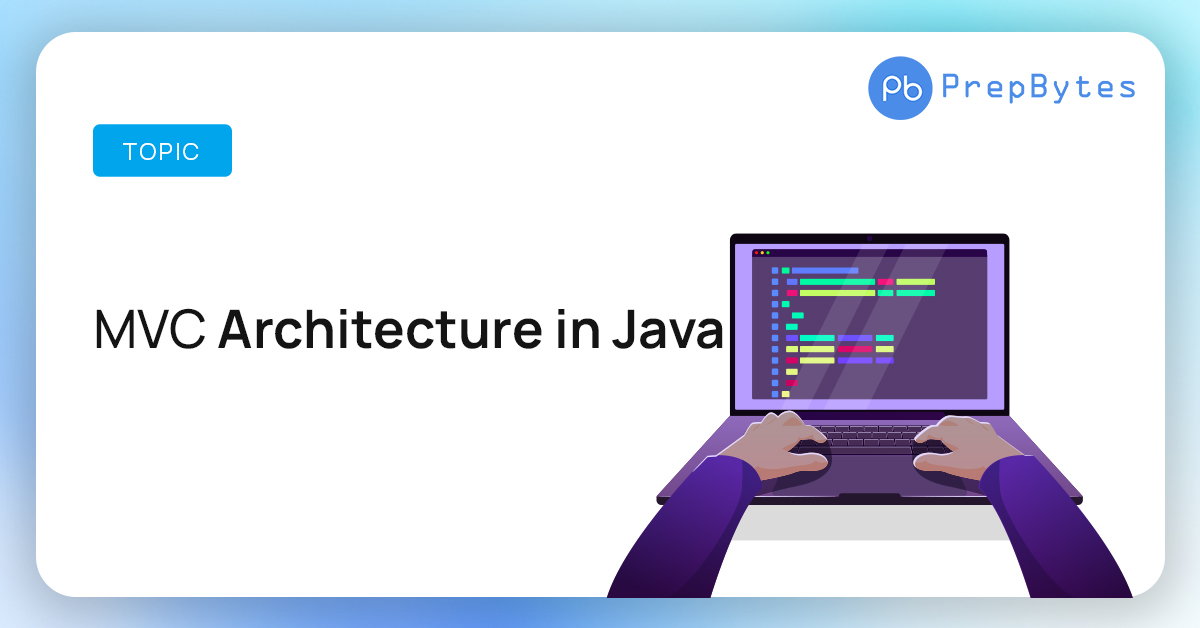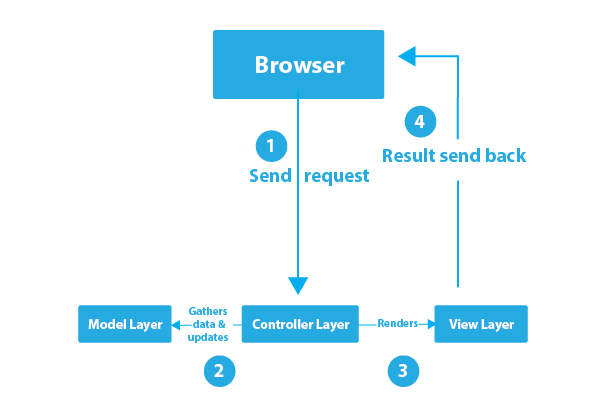Last Updated on July 4, 2024 by Abhishek Sharma

Model-View-Controller (MVC) is a design pattern that separates an application into three interconnected components: Model, View, and Controller. This separation helps in organizing code, making it more modular, and enhancing the reusability and scalability of the application. MVC architecture is widely used in Java applications, especially in web development, as it provides a clear structure for building interactive applications with a clean separation of concerns.
In the upcoming section, we will explore the MVC Architecture in Java. We will delve into its benefits and drawbacks, and provide examples to illustrate the implementation of MVC in Java.
What is MVC Architecture in Java?
The Model-View-Controller (MVC) architecture in Java is a design pattern that provides a structured approach for developing applications. It separates the application’s concerns into three main components: the model, the view, and the controller. Each component has a specific role and responsibility within the architecture.
-
Model:
The model represents the data and business logic of the application. It encapsulates the application’s data and provides methods for accessing, manipulating, and updating that data. The model component is independent of the user interface and focuses solely on the application’s functionality. -
View:
The view is responsible for rendering the user interface and displaying the data to the user. It presents the data from the model to the user in a visually appealing and understandable way. The view component does not contain any business logic but instead relies on the model for data. -
Controller:
The controller acts as an intermediary between the model and the view. It handles user input, processes user actions, and updates the model or view accordingly. The controller interprets user actions and triggers the appropriate methods in the model or view. It ensures the separation of concerns by keeping the view and model independent of each other.
In Java programming, the Model comprises basic Java classes that encapsulate data and business logic. The View is responsible for presenting the data to the user interface, while the Controller consists of servlets that handle user requests. This clear separation of components enables the following processing flow for user requests:

In the context of the server-client architecture, the process of handling a page request can be described as follows:
- A client, typically a web browser, initiates a request and sends it to the server-side controller.
- The controller receives the request and interacts with the model component. It retrieves the necessary data from the model, which may involve processing and manipulating the data as required.
- Once the controller has gathered the requested data, it transfers this data to the view layer.
- The view layer, utilizing the provided data, generates the appropriate output or representation of the requested page. Finally, the generated result is sent back to the client’s browser, completing the request-response cycle.
Advantages of MVC Architecture in Java
The MVC (Model-View-Controller) architecture offers several advantages in Java development:
- Separation of Concerns: MVC promotes a clear separation of concerns between the model, view, and controller components. This separation allows for better code organization, improved modularity, and easier maintenance. Developers can focus on specific aspects of the application without impacting other components.
- Code Reusability: By separating the concerns into distinct components, code reuse becomes more feasible. The model can be reused across different views, and multiple views can be created for a single model. This reusability reduces duplication of code and improves development efficiency.
- Simultaneous Development: MVC allows multiple developers to work simultaneously on different components. The model, view, and controller can be developed independently as long as they adhere to the defined interfaces and communication protocols. This parallel development approach accelerates the overall development process.
- Flexibility and Extensibility: MVC provides flexibility by allowing changes in one component without affecting others. For example, modifying the view does not require altering the model or controller. This flexibility also enables the easy addition of new views or controllers to enhance the application’s functionality.
- Testability: The separation of concerns in MVC makes unit testing and debugging more manageable. Each component can be independently tested, as they have well-defined responsibilities and interfaces. This promotes comprehensive testing, reduces dependencies, and improves the overall quality of the application.
- Enhanced User Experience: With MVC, the view layer handles the presentation of data to the user. This separation allows for greater control over the user interface and enables the use of different views for different platforms or devices. Developers can create responsive and user-friendly interfaces tailored to specific user needs.
- Support for Maintainability: MVC simplifies the maintenance of applications over time. Changes can be made to individual components without requiring extensive modifications to the entire system. This modularity enhances maintainability and reduces the risk of introducing bugs or breaking existing functionality.
Implementation of MVC using Java
To adhere to the MVC pattern in Java implementation, it is necessary to create the following three classes:
- Employee Class, will act as model layer
- EmployeeView Class, will act as a view layer
- EmployeeContoller Class, will act a controller layer
MVC Architecture Layers
MVC Architecture Layers are:
1. Model Layer:
In the MVC design pattern, the Model component serves as the data layer of the application. It encompasses the business logic and maintains the state of the application. The Model object is responsible for retrieving and storing the application’s data in a database. It applies rules and validations to the data, reflecting the core concepts and functionality of the application. Through the Model layer, the application’s data is managed and processed, ensuring adherence to the defined rules and behaviors.
Let’s consider the following code snippet that creates a which is also the first step to implement MVC pattern.
// class that represents model
public class Employee {
// declaring the variables
private String EmployeeName;
private String EmployeeId;
private String EmployeeDepartment;
// defining getter and setter methods
public String getId() {
return EmployeeId;
}
public void setId(String id) {
this.EmployeeId = id;
}
public String getName() {
return EmployeeName;
}
public void setName(String name) {
this.EmployeeName = name;
}
public String getDepartment() {
return EmployeeDepartment;
}
public void setDepartment(String Department) {
this.EmployeeDepartment = Department;
}
} The above code simply consists of getter and setter methods to the Employee class.
2. View Layer
As the name implies, the View component in the MVC pattern is responsible for presenting the data obtained from the Model. It represents the visual representation or user interface of the application. The View layer generates the output of the application and communicates it to the client. The requested data is fetched from the Model layer by the Controller and passed to the View for rendering and display to the user or client. The View component ensures that the data is presented in a format that is suitable for the user interface or output requirements of the application.
Let’s take an example where we create a view using the EmployeeView class.
// class which represents the view
public class EmployeeView {
// method to display the Employee details
public void printEmployeeDetails (String EmployeeName, String EmployeeId, String EmployeeDepartment){
System.out.println("Employee Details: ");
System.out.println("Name: " + EmployeeName);
System.out.println("Employee ID: " + EmployeeId);
System.out.println("Employee Department: " + EmployeeDepartment);
}
} 3. Controller Layer
In the MVC architecture, the Controller layer receives user requests from the View layer and handles them, including necessary validations and logic. It serves as the intermediary between the Model and View components. The Controller processes the user requests and forwards them to the Model layer for data processing. Once the requested data is processed by the Model, it is returned to the Controller. The Controller then transfers the data to the appropriate View, where it is displayed to the user. The Controller orchestrates the flow of data between the Model and View, ensuring the proper handling and presentation of the application’s functionality.
Let’s consider the following code snippet that creates the controller using the EmployeeController class.
// class which represents the controller
public class EmployeeController {
// declaring the variables model and view
private Employee model;
private EmployeeView view;
// constructor to initialize
public EmployeeController(Employee model, EmployeeView view) {
this.model = model;
this.view = view;
}
// getter and setter methods
public void setEmployeeName(String name){
model.setName(name);
}
public String getEmployeeName(){
return model.getName();
}
public void setEmployeeId(String id){
model.setId(id);
}
public String getEmployeeId(){
return model.getId();
}
public void setEmployeeDepartment(String Department){
model.setDepartment(Department);
}
public String getEmployeeDepartment(){
return model.getDepartment();
}
// method to update view
public void updateView() {
view.printEmployeeDetails(model.getName(), model.getId(), model.getDepartment());
}
} Conclusion
The Model-View-Controller (MVC) architecture in Java provides a structured and modular approach to developing applications. It separates concerns into three components: the Model, View, and Controller. The Model represents the data and business logic, the View handles the user interface and presentation of data, and the Controller acts as the intermediary, processing user input and managing the interaction between the Model and View. MVC offers advantages such as separation of concerns, code reusability, flexibility, and testability, ultimately leading to more maintainable and scalable Java applications.
FAQs related to MVC Architecture in Java
Frequently asked questions related to MVC Architecture in Java:
1. What is MVC Architecture?
MVC (Model-View-Controller) is a design pattern that separates an application into three main components: Model, View, and Controller. This separation helps in organizing code, enhancing modularity, and improving maintainability.
2. What are the roles of Model, View, and Controller in MVC?
- Model: Manages the data and business logic.
- View: Handles the display and user interface.
- Controller: Manages user input and interactions, and updates the Model and View.
3. Why is MVC Architecture important in Java applications?
MVC Architecture provides a clear separation of concerns, making the application easier to manage, test, and scale. It enhances modularity, reusability, and maintainability, which are crucial for large and complex Java applications.
4. How do you implement MVC Architecture in a Java web application?
Java web applications often use frameworks like Spring MVC, Struts, or JavaServer Faces (JSF) to implement the MVC pattern. These frameworks provide built-in support for the MVC components and help in organizing the application structure.
5. What is the role of a framework like Spring MVC in implementing MVC Architecture?
Spring MVC is a popular framework for building web applications in Java. It provides tools and features to implement the MVC pattern, such as annotation-based controllers, view resolvers, and model attributes, simplifying the development of MVC-based applications.
6. Can you use MVC Architecture in desktop applications?
Yes, MVC Architecture can be used in desktop applications. Frameworks like JavaFX and Swing support the MVC pattern, helping to create well-structured and maintainable desktop applications.


